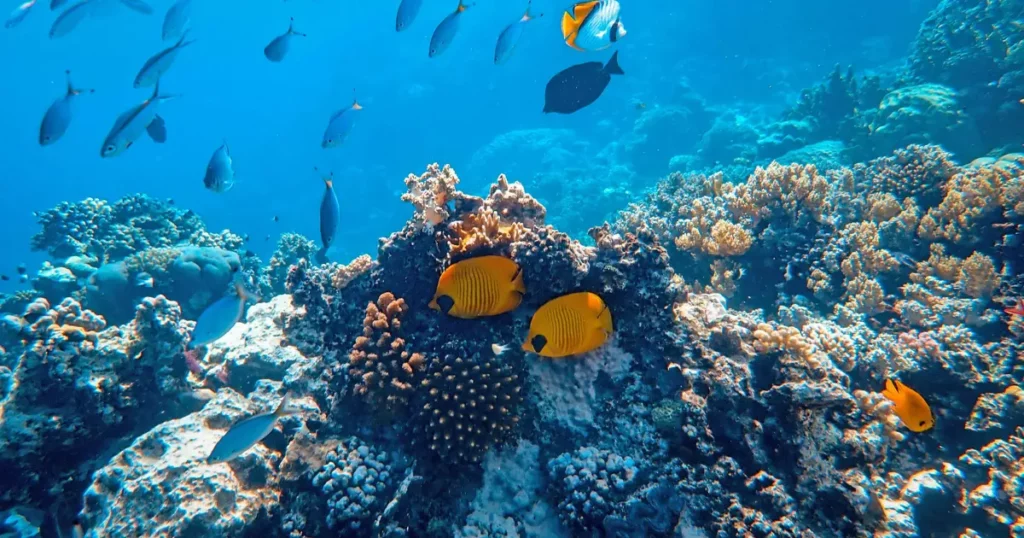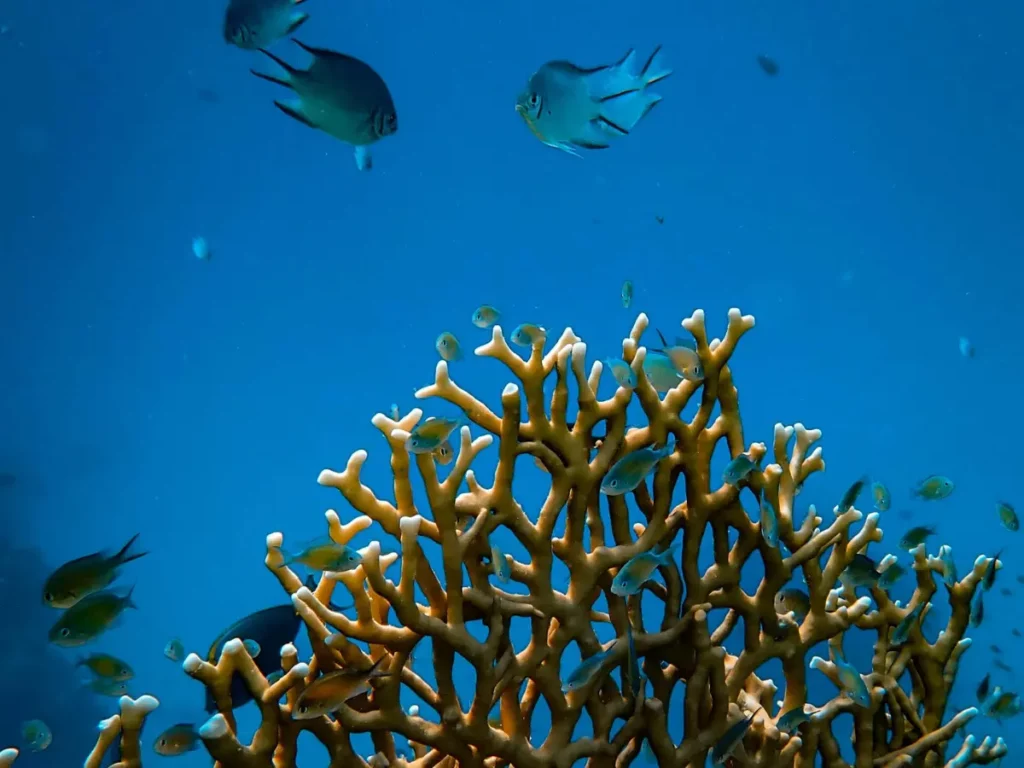
The entire ecosystem that rivals rainforests, lies beneath the ocean’s surface in variety and density. The coral reef is the major element of this hidden world. People often refer to it as the “rainforests of the sea.” Hence, these pulsating underwater structures house a wide range of creatures that are comparable to terrestrial jungles.
Structural Complexity
Coral reeves showcase structural complexity similar to that of rainforests. Both ecosystems serve a variety of functions for different species. Coral reefs consist of distinct zones, including the reef flat, crest, and fore reef. This three-dimensional structure creates abundant microhabitats, supporting diverse life forms. However, an ecosystem that rivals rainforests in complexity is essential for maintaining ecological balance.
Biodiversity Comparison
An ecosystem that rivals rainforests must match their species richness. Coral has impressively achieved this act. Rainforests cover less than 2% of Earth’s surface but contain over 50% of terrestrial species. In comparison, coral reefs occupy less than 1% of the ocean floor yet support about 25% of all marine life. This remarkable biodiversity signifies the presence of ecosystem that rivals rainforests.
Global Significance
Coral reefs have a crucial role in global processes. They protect coastlines from storms and erosion. This ecosystem that rivals rainforests play a vital role in ocean health and contribute a significant part to marine nitrogen and carbon cycles. Their preservation is essential for maintaining ecological integrity.
Threats and challenges
Climate Change Impact
Climate change is significantly threatening ecosystem that rivals rainforests. The adverse effect of this change is a gradual increase in ocean temperatures, leading to coral bleaching, which in turn weakens coral structures due to ocean acidification. We witnessed a severe bleaching event from 2016 to 2017, when the Great Barrier Reef weakened over two-thirds of the reef. These effects highlight the vulnerability of ecosystem that rivals rainforests
Human Activities
Pollution, overfishing, and other destructive practices degrade the health of coral reefs. Coastal development, disguised as “development,” further jeopardizes these ecosystems, which are comparable to rainforests. The World Resources Institute estimates that 75% of coral reefs face local and global pressures. These damages threaten the fragile balance of marine life.
Pollution
Plastic waste suffocates marine life, increases diseases, contaminates the food chain, and damages habitats. Furthermore, agricultural runoff, such as fertilizers, pesticides, soil, or sediments, as well as industrial pollutants, contaminate both reef and rainforest ecosystems. This pollution threatens the existence of ecosystem that rivals rainforests, emphasizing the need for urgent action.
Conservation Efforts
Protecting these exceptional ecosystems requires global cooperation. Restoration programs and sustainable governance approaches are crucial. Climate change reduction efforts play a pivotal role in stabilizing ecosystem that rivals rainforests. Collective efforts can help revitalize and preserve these irreplaceable habitats.
Conservation efforts for coral reefs
Marine Protected Areas (MPAs)

Experts establish MPAs, which is one of the most effective strategies for coral reef conservation. These specified areas restrict fishing and other activities so that coral ecosystems can survive and recover. MPAs serve as safe havens for marine species and enhance the immunity of coral reefs to environmental stressors.
Community Engagement
Local community engagement is critical for coral reef conservation, but involving stakeholders promotes a sense of ownership and encourages sustainable fishing practices. This community-stakeholder collaboration approach is significant for the long-term sustainability of coral reefs.
Innovative restoration techniques
Since then, the experts have put in tremendous efforts to restore coral reefs. Therefore, coral gardening, breeding corals in tanks, and transplanting them onto reefs are some of the prominent techniques. However, experts are working on developing some advanced methods, such as microfragmentation and larval propagation.
To enhance coral reproduction and resilience
Coral Gardening
Coral gardening, or coral farming, involves cultivating coral fragments to restore damaged reefs. Ocean-based or land-based nurseries collect and nurture small coral pieces. In ocean nurseries, fragments grow attached to underwater structures, while land-based nurseries allow for faster growth through techniques like microfragmentation. Experts transplant these corals back onto degraded reefs after six to twelve months, enhancing coral populations and resilience against environmental stressors.
Breeding corals in tanks
Breeding corals in tanks entails cultivating coral polyps in controlled environments, such as aquariums. This method allows scientists to study coral reproduction and growth, leading to the development of more resilient strains. Scientists collect coral larvae during spawning events and raise them in tanks until they are ready for transplantation. This approach aids research and helps identify optimal conditions for healthy coral growth and reproduction.
Transplanting Corals onto Reefs
Transplanting corals onto reefs is the final step in coral restoration. After thriving in nurseries, experts relocate corals to damaged reef areas, assess their health, and select suitable sites. This process restores biodiversity and ecosystem functions, providing habitat for marine species. Ongoing monitoring is essential to ensure the transplanted corals adapt well and thrive alongside existing populations.
Microfragmentation
Microfragmentation is a coral restoration technique that involves cutting corals into small fragments, allowing them to grow and fuse together. This method accelerates coral growth by 10 to 40 times compared to natural rates, increasing surface area and reducing competition. It is particularly beneficial for slow-growing coral species, which are critical for reef stability. You can transplant the mature microfragments back onto degraded reefs, effectively restoring biodiversity and ecosystem functions.
Larval Propagation
Larval propagation aims to enhance coral genetic diversity and resilience through sexual reproduction. This method involves collecting coral gametes during spawning, fertilizing them in controlled environments, and nurturing the resulting larvae until they can settle on suitable substrates. By facilitating natural reproductive processes, larval propagation produces diverse coral genotypes that are more resilient to environmental stressors. This technique not only replenishes coral populations but also bolsters the genetic diversity essential for the long-term survival of reefs amid climate change and other threats.
Restoration of coral reefs using innovative technologies
We are using several innovative technologies to restore and conserve coral reefs.
Biorock Technology
Biorock technology uses low-voltage electrical currents to stimulate coral growth by precipitating dissolved minerals from seawater onto submerged steel structures, forming a limestone coating. This process allows coral fragments attached to these structures to grow 2–6 times faster than normal, enhancing their survival rates against environmental stressors. The technology not only supports coral growth but also provides habitats for various marine organisms, contributing to the overall health of coral ecosystems.
3D Printing
Artificial reef structures replicate the texture and shape of natural reefs through the use of 3D printing, thereby facilitating coral attachment and growth. Researchers have tested these structures in regions such as the Mediterranean, Caribbean, and Australia. For instance, Reef Design Labs has introduced a modular artificial reef in the Maldives that attracts fish and supports coral growth. This customizable approach allows for tailored solutions to local environmental conditions, offering promising results for reef restoration efforts.
Assisted Evolution
Assisted evolution focuses on breeding corals that are more resilient to climate change impacts, such as warming ocean temperatures and acidification. By selectively breeding the most heat-tolerant coral individuals, scientists aim to produce offspring better equipped to withstand environmental stressors. This technique enhances the resilience of coral populations, contributing to their long-term survival in changing marine environments.
Acoustic Enrichment
Acoustic enrichment involves playing recordings of healthy coral reef sounds in degraded areas to attract juvenile fish and invertebrates. Research has demonstrated that this method significantly boosts fish abundance in degraded reefs across various trophic levels. Acoustic enrichment helps facilitate the recovery of marine ecosystems by restoring the acoustic environment and enhancing biodiversity in impacted areas. Other innovative technologies being used include:
Cloud Brightening to Cool Reef Waters
Climate engineers propose marine cloud brightening as a technique to cool coral reefs by enhancing cloud reflectivity. This involves spraying microscopic sea salt crystals into the atmosphere to act as cloud condensation nuclei, resulting in brighter clouds that reflect more sunlight and reduce ocean surface temperatures. Modeling studies suggest that implementing this technique over the Great Barrier Reef during high bleaching risk periods could provide a temporary “breathing space” for corals to recover from warming and acidification. However, aggressive emissions reductions and further research are necessary to understand potential risks and impacts on local weather patterns, as it is not a permanent solution.
Heat-Tolerant Algae to Boost Coral Resilience
The use of heat-tolerant algae, specifically certain strains of Zooxanthellae, aims to enhance coral resilience against rising ocean temperatures. Research has shown that corals hosting heat-tolerant algae, such as Durusdinium glynnii, are better equipped to survive in warmer waters. While these algae improve survival rates, there is a trade-off in growth rates: corals with heat-tolerant algae may grow more slowly in warmer conditions, but they are more likely to endure heat stress. Understanding the role of these algae is crucial for conservation efforts as researchers explore methods to promote coral species that can associate with heat-tolerant strains.
Using Coral IVF to grow corals in labs
Coral IVF, also known as in vitro fertilization, is a technique that restores damaged coral reefs by breeding corals in controlled environments. This process involves collecting coral eggs and sperm during mass spawning events, fertilizing them in ocean pools, and nurturing the resulting larvae until they can settle and grow into juvenile corals. Pioneered by Professor Peter Harrison, coral IVF has shown promising results in increasing the number of breeding corals in degraded areas. A key aspect of this method is the selection of heat-resistant coral species, aiming to produce larvae that inherit these traits for better survival in warmer waters.
Applications and Future Directions
Restoration Efforts
Locations like the Great Barrier Reef and the Caribbean have successfully implemented Coral IVF to restore coral populations and improve ecosystem health. This scalable technique can produce millions of larvae for release into damaged reefs. Researchers are also developing underwater robots to efficiently distribute coral larvae, as well as experimenting with the soundscapes of healthy reefs to attract larvae to degraded areas. Collaboration with local communities and organizations further supports these initiatives, increasing public awareness and participation in coral conservation.
Underwater 3D mapping
Underwater 3D mapping utilizes advanced photogrammetry and computer vision to create detailed models of coral reefs, providing insights into their health and structure. This technique captures overlapping images of the reef, then processes them to reconstruct its 3D structure. Semantic segmentation uses artificial intelligence to classify coral species and their health status. By comparing maps over time, researchers can monitor changes in coral cover and species composition, informing conservation strategies and restoration efforts.
Soft robotics
Soft robotics is a transformative technology for coral restoration, employing flexible materials to gently interact with delicate coral ecosystems. These robots can handle coral without causing damage and navigate complex reef environments more effectively than traditional rigid robots. By integrating artificial intelligence, soft robotics enhances the efficiency of tasks such as coral fragment planting and data collection while also facilitating assisted coral migration to more favorable environments as ocean conditions change.
Applications of Soft Robotics
The applications of soft robotics in coral restoration are significant.
Gentle Manipulation: Soft robotic grippers delicately handle fragile coral species, preventing damage during sampling and transplantation. Their design allows for safe retrieval, which is crucial for maintaining reef health.
Exploration and Data Collection: Inspired by jellyfish, soft robots can navigate coral reefs with minimal disturbance to marine life, performing tasks like object manipulation and transportation.
AI and Automation: Advancements in AI enable robotic arms to efficiently plant coral fragments, significantly speeding up the labor-intensive restoration process.
Assisted Coral Migration: Soft robotics can facilitate the careful relocation of corals to better environments, helping to preserve coral species amid climate change.
The advantages of soft robotics
Minimized Environmental Impact: The flexible nature of soft robots reduces the risk of damaging sensitive coral ecosystems.
Enhanced Efficiency: Automation improves precision in coral handling, increasing the effectiveness of restoration efforts.
Research and Monitoring: Soft robots assist in collecting data on coral health without disturbing natural habitats, providing valuable insights for conservation strategies. These technologies, combined with traditional conservation efforts, offer hope for restoring the world’s precious coral reef ecosystems in the face of climate change and other threats.
Addressing Water Quality
Coral reefs are particularly vulnerable to pollution, especially from land-based sources. Conservation efforts focus on improving water quality by reducing runoff and managing wastewater, which directly impacts coral health.
Hence, Coral Conservation Strategies are increasingly incorporating climate change adaptation measures. This includes developing resilient coral strains and employing technologies to monitor reef health and predict future threats.
Global Impact
The decline of coral reef ecosystem that rivals rainforests in biodiversity, affects the entire planet. It leads to biodiversity loss, disrupts climate regulation, and impacts ocean health. These changes influence organisms worldwide, from polar bears to migratory birds. The interconnectedness of ecosystems underscores the importance of preserving coral reefs.
Human Well-being
Human well-being directly correlates with the health of coral reef ecosystems. They provide valuable medicines and support local economies through tourism and fisheries. The decline of these ecosystems threatens food security and increases vulnerability to natural disasters.
Call to Action
Since, saving coral reef ecosystems requires collective effort. Therefore, Governments organizations, businesses, and individuals must work together to implement sustainable practices and support conservation initiatives. By reducing pollution, managing wastewater, and developing climate change adaptation measures, we can protect these vital ecosystems for future generations.
Coral reef preservation is critical for the health of our planet and humanity. Ecosystem that rivals rainforests in their complexity and biodiversity, and their decline has far-reaching consequences. By recognizing the importance of coral reefs and taking action to protect them, we can ensure their survival and the continued well-being of our planet.
Also check out Elon Musk’s Neuralink Company’s, Brain-Computer Interface: Bridging Brains and Bytes
Citations:
- https://rainforests.mongabay.com
- https://education.nationalgeographic.org/resource/rain-forest/
- https://nationalzoo.si.edu/center-conservation-sustainability/news/heights-unseen-hidden-world-tropical-rainforests
- https://worldrainforests.com/facts/rainforest-facts.html
- https://panthera.org/blog-post/secrets-rainforest
- https://www.graygroupintl.com/blog/coral-reef-conservation
- https://www.nature.org/en-us/about-us/where-we-work/caribbean/stories-in-caribbean/caribbean-a-revolution-in-coral-conservation/
- https://coral.org/en/blog/restoration/
- https://www.fisheries.noaa.gov/national/habitat-conservation/restoring-coral-reefs
- https://www.unep.org/resources/report/coral-reef-restoration-guide-coral-restoration-method
- https://www.coralrestoration.org
- https://www.nationalgeographic.com/travel/article/how-can-get-involved-coral-reef-restoration-projects
- https://www.marinebio.org/conservation/coral-restoration/
- https://link.springer.com/chapter/10.1007/978-94-011-4215-1_13
- https://news.mongabay.com/2018/08/a-new-dimension-to-marine-restoration-3d-printing-coral-reefs/
- https://www.thenationalnews.com/business/future/2023/10/24/can-3d-printing-help-restore-coral-reefs/
- https://openknowledge.fao.org/server/api/core/bitstreams/dd4d2de4-8252-41f8-b162-778ee28ce00c/content
- https://www.sciencedaily.com/releases/2022/04/220426101636.htm
- https://www.barrierreef.org/news/explainers/what-is-cloud-brightening
- https://www.sciencedaily.com/releases/2013/07/130710103434.htm
- https://en.wikipedia.org/wiki/Marine_cloud_brightening
- https://www.thehindu.com/sci-tech/energy-and-environment/could-marine-cloud-brightening-reduce-coral-bleaching-on-the-great-barrier-reef/article67429988.ece
- https://phys.org/news/2020-04-scientists-cloud-brightening-great-barrier.html
- https://www.soest.hawaii.edu/soestwp/announce/news/heat-tolerant-coral-tradeoff/
- https://phys.org/news/2023-11-heat-tolerant-coral-fast-growth-resilience.html
- https://digitalcommons.odu.edu/cgi/viewcontent.cgi?article=1114&context=ourj
- https://www.washingtonpost.com/science/2023/02/25/algae-coral-reefs-survival/
- https://www.udel.edu/udaily/2023/december/coral-reefs-reef-bleaching-ocean-global-warming-heat-tolerance-tolerant-corals/
- https://en.reset.org/ivf-for-coral-reefs-coral-babies-grow-to-maturity-in-breakthrough-restoration-research/
- https://www.scu.edu.au/news/2023/evolution-of-coral-ivf-enhances-recovery-of-coral-reefs/
- https://phys.org/news/2023-01-evolution-coral-ivf-recovery-reefs.html
- https://www.theguardian.com/environment/2024/apr/20/scientists-experiment-is-beacon-of-hope-for-coral-reefs-on-brink-of-global-collapse
- https://www.scu.edu.au/coral-ivf/
- http://ieeexplore.ieee.org/document/4059278/
- https://www.youtube.com/watch?v=yb71wwgVJ1w
- https://divernet.com/photography/technique/now-any-diver-can-map-reefs-in-3d-and-fast/
- https://besjournals.onlinelibrary.wiley.com/doi/10.1111/2041-210X.14307
- https://www.researchgate.net/publication/4245816_Underwater_3D_Mapping_Experiences_and_Lessons_learned
- https://www.ncbi.nlm.nih.gov/pmc/articles/PMC4997628/
- https://www.researchgate.net/publication/333427641_Eversion_and_Retraction_of_a_Soft_Robot_Towards_the_Exploration_of_Coral_Reefs
- https://divemagazine.com/scuba-diving-news/ai-and-robotics-being-used-to-revive-coral-reefs
- https://news.mit.edu/2018/soft-robotic-fish-swims-alongside-real-ones-coral-reefs-0321
- https://aiforgood.itu.int/robots-for-ocean-conservation-combating-pollution-and-preserving-marine-life/
- https://www.essentialmagazine.com/how-coral-gardening-is-saving-reefs/
- https://luxiders.com/coral-gardening-a-path-to-preserve-our-coral-reefs/
- https://www.researchgate.net/publication/371781829_Coral_Gardening_An_Innovative_Technique_to_Management_and_Conservation_of_the_Degraded_Habitats_of_Coral
- https://en.wikipedia.org/wiki/Aquaculture_of_coral
- https://www.youtube.com/watch?v=0UlnRnHWFqU



